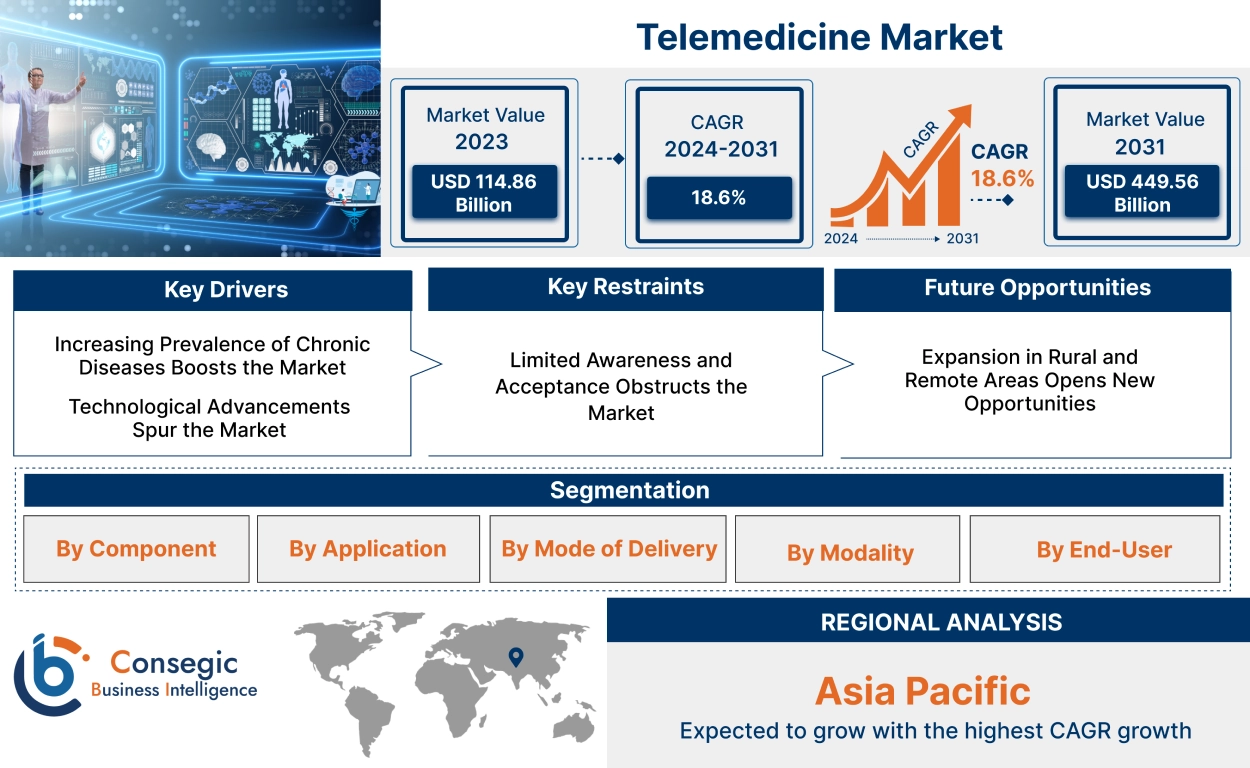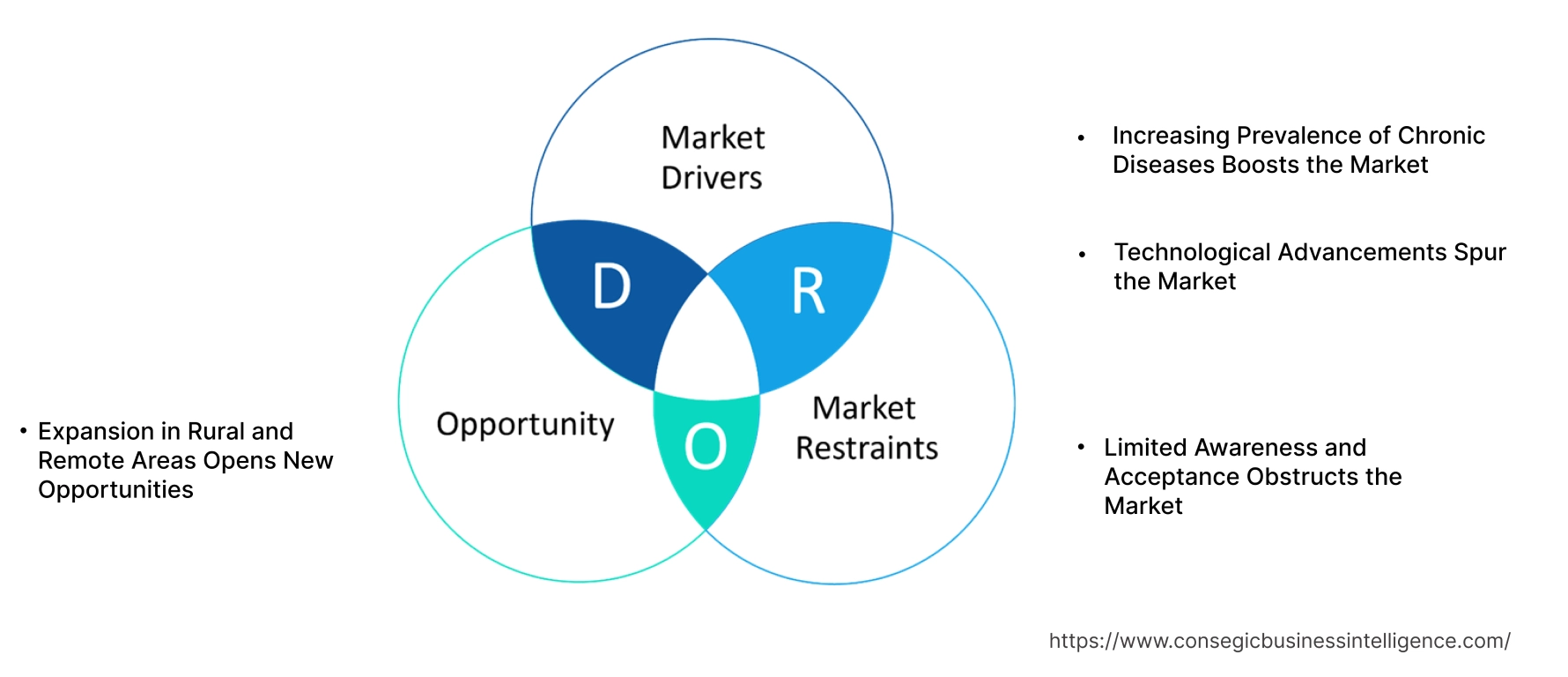- Summary
- Table Of Content
- Methodology
Telemedicine Market Size:
Telemedicine Market size is estimated to reach over USD 449.56 Billion by 2031 from a value of USD 114.86 Billion in 2023 and is projected to grow by USD 134.17 Billion in 2024, growing at a CAGR of 18.6% from 2024 to 2031.
Telemedicine Market Scope & Overview:
Telemedicine includes a broad spectrum of products and services that provide clinical care from a distance. It involves giving patients remote medical care, consultation, diagnosis, and treatment through digital communication and telecommunications technology, including computers, smartphones, and the Internet. The market encompasses various applications, such as digital consultations across medical specialties, telehealth services, remote monitoring, and virtual doctor visits. The necessity for effective chronic illness management, the growing acceptance of virtual healthcare services by patients and healthcare professionals, the progress of communication technology, and the growing need for easily accessible healthcare have all contributed to the telemedicine market expansion.
Telemedicine Market Insights:
Key Drivers:
Increasing Prevalence of Chronic Diseases Boosts the Market
Growing rates of chronic illnesses like diabetes, heart disease, and hypertension have been a major factor in the market. Through the provision of continuous care, enhanced drug adherence, and remote monitoring, telemedicine provides a workable approach to addressing chronic illnesses. It has a transformative impact on chronic disease management, offering convenient, efficient, and cost-effective healthcare solutions.
- For instance, Dexcom, specializing in continuous glucose monitoring systems has integrated its devices with platforms, enabling the users to manage their condition effectively.
The increasing rate of chronic diseases indicates a growing shift towards more integrated and accessible healthcare solutions.
Technological Advancements Spur the Market
The global telemedicine market has grown significantly as a result of technological improvements. Technological advancements in wearables, medical software, and telecommunications include enhanced sensors, integration with health apps, AI and machine learning, telehealth platforms, enhanced connectivity, and more. This has improved the efficacy and efficiency of services.
- For example, A Royal Philips report from 2021 states that a large sum of money has been invested in AI technology to support telehealth services. This includes the application of AI to medical imaging and diagnostics, which by 2026 is expected to be utilized in two-thirds of these procedures.
Thus, technological developments are improving the effectiveness and inclusivity of healthcare, and in turn, boosting the market.
Key Restraints :
Limited Awareness and Acceptance Obstructs the Market
A lack of acceptance and knowledge seriously impedes the market. This restriction frequently shows itself as mistrust or a lack of knowledge about the advantages and efficacy of telemedicine.
- For instance, in 2022 British Medical Journal (BMJ) report, UK, revealed that many healthcare providers had doubts about the efficacy, especially when it came to how it might affect patient outcomes. Part of this skepticism stemmed from worries about data security and care quality.
- A 2023 survey by the Australian Health Review found that patients were reluctant to use telemedicine because they were worried about data security and privacy. The lack of clarity surrounding the handling of sensitive health information by platforms added to this hesitancy.
Thus, the limited awareness about telemedicine restraints the market.
Future Opportunities :
Expansion in Rural and Remote Areas Opens New Opportunities
The expansion of telemedicine provides underserved regions with access to quality medical care that was previously limited. This not only improves health outcomes by offering timely medical consultations and specialist care but also fosters greater health equity by ensuring that remote populations receive the same level of attention and resources as those in urban centers.
- For instance, according to the Australian Journal of Rural Health telemedicine programs for Indigenous communities in distant locations were sponsored by the federal government. By offering these populations, who have historically had to travel great distances to receive treatment, virtual consultations, and specialized services, the program aims to minimize health inequities.
Therefore, accommodating rural regions promotes the telemedicine market opportunities.
Telemedicine Market Segmental Analysis :
By Component:
Based on the component, the market is segmented into Hardware (Monitors, Wearable Devices, and Others), Software (Integrated Software and Standalone Software), and Services (Tele-education, Tele-monitoring, Tele-consultation, Tele-care, and Tele-surgery).
Trends in the component:
- Rapid advancements in technologies, including the integration of Artificial Intelligence (AI) and the implementation of Picture Archiving and Communication Systems (PACS), are enhancing service offerings like teleradiology.
- The growing awareness and adoption particularly in mental health services (telepsychiatry), is another critical trend.
The services segment accounted for the largest revenue of 52.14% in 2023.
- The services segment includes tele-education, tele-monitoring, tele-consultation, tele-care, and tele-surgery.
- The teleconsultation is growing due to the increasing adoption of remote healthcare solutions, advancements in communication technologies, and a greater focus on patient-centered care.
- Therefore, the services segment is anticipated to boost the telemedicine market share.
The software segment is anticipated to register the fastest CAGR during the forecast period.
- The software segment plays a crucial role in the market, driving significant revenue due to the increasing adoption of telehealth platforms and digital health solutions.
- It is driven by the growing need for virtual consultations, remote patient monitoring, and telehealth services.
- For instance, Mayo Clinic's "Advanced Care at Home" program, launched in collaboration with Medically Home, allows patients to receive hospital-level care at home, demonstrating the effectiveness of the software in managing complex cases outside traditional hospital settings. This program has been pivotal in managing COVID-19 patients and chronic conditions and providing continuous care through digital platforms.
- Thus, the software segment drives the telemedicine market opportunities.
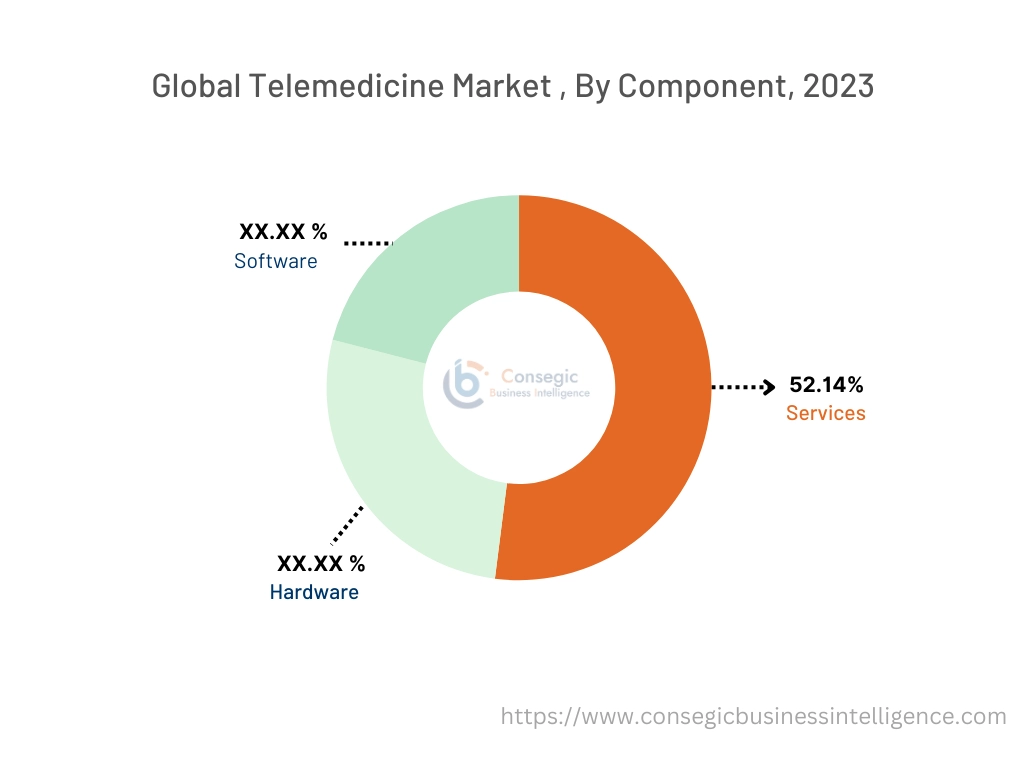
By Application :
Based on the application, the market is segmented into telepathology, telecardiology, teleradiology, teledermatology, telepsychiatry, teleophthalmology, and others.
Trends in the application:
- The adoption of whole-slide imaging (WSI) technology is growing. WSI allows for high-resolution digital images of pathology slides, which can be shared and analyzed remotely.
- Telecardiology is expanding to include virtual cardiac rehabilitation programs, allowing patients to engage in supervised exercise and education from home.
- AI-driven tools are increasingly used to analyze dermatological images and provide preliminary diagnoses or recommendations, streamlining the diagnostic process.
The Teleradiology segment accounted for the largest revenue in 2023.
- Teleradiology involves the transmission of radiographic images from one location to another for remote interpretation and diagnosis.
- It enables radiologists to review and analyze imaging studies, such as X-rays, CT scans, and MRIs, from any location, facilitating timely diagnosis and collaboration across healthcare facilities.
- As per the analysis, this dominance is attributed to the growing need for remote diagnostic imaging services, which allows radiologists to interpret imaging studies from different locations, thus improving access to radiology services.
- For instance, in 2023 RadNet expanded its services due to increased demand for remote diagnostic imaging services. This allowed RadNet to offer more accessible and efficient imaging services, leveraging technology to provide timely diagnostic support and meet the needs of a broader patient base.
- Thus, the teleradiology segment drives the telemedicine market demand.
The Telepsychiatry segment is anticipated to register the fastest CAGR during the forecast period.
- Telepsychiatry involves providing psychiatric evaluation, therapy, and medication management remotely through digital communication platforms.
- It offers patients access to mental health care from the comfort of their homes, improving access and convenience while addressing issues like stigma and geographical barriers.
- The analysis shows that this approach enables psychiatrists to deliver consistent, high-quality care to patients in diverse settings.
- This is driven by the increasing need for mental health services and the convenience of remote consultations, which make mental health care more accessible.
- For instance, BetterHelp offers a comprehensive telepsychiatry platform that provides online therapy and counseling services through video, chat, and messaging, making mental health support more accessible.
- Therefore, the Telepsychiatry segment is expected to boost the telemedicine market trends.
By Mode of Delivery:
Based on the mode of delivery, the market is segmented into On-premise Delivery, Cloud-based Delivery, and Web-based Delivery.
Trends in the mode of delivery:
- Web-based solutions are popular due to their ease of use and minimal technical requirements for both healthcare providers and patients. They can be accessed via standard web browsers, reducing the need for specialized software.
- There is a trend towards customizing on-premise solutions to meet the specific needs of healthcare organizations. Integration with existing hospital information systems (HIS) and electronic health records (EHR) is also becoming more prevalent.
The Cloud-based delivery segment accounted for the largest revenue share in 2023 and is anticipated to register the fastest CAGR during the forecast period.
- Cloud-based delivery refers to the use of cloud computing technologies to provide services and applications over the Internet.
- Analysis shows that this enables flexible, scalable, and on-demand access to software and data storage, allowing users to access and manage their resources from anywhere, without the need for local infrastructure.
- This segment's dominance is due to the flexibility, scalability, and cost-effectiveness of cloud-based solutions, which are increasingly favored by healthcare providers for applications.
- For instance, according to Zymr, the increasing adoption of cloud technologies by healthcare providers to enhance patient care and streamline operations. Cloud-based solutions offer benefits such as scalability, cost-effectiveness, and accessibility, which are driving their rapid adoption.
- Thus, the cloud-based delivery segment boosts the telemedicine market demand.
By Modality:
Based on modality, the market is segmented into Real-Time (Synchronous) (Video Conferencing, Audio Conferencing, and Chat), Store-and-Forward (Asynchronous) (Image Sharing and Data Sharing), Remote Patient Monitoring (Wearable Devices, Mobile Health Applications), and Others (Tele-ICU, Tele-surgery)).
Trends in the Modality:
- There is a significant increase in the adoption of video conferencing, driven by the need for more interactive and personal consultations. Advancements in video technology and internet bandwidth are improving the quality and reliability of these sessions.
- The use of image sharing for diagnostics is expanding, allowing healthcare providers to review and analyze medical images at their convenience. This is particularly useful for specialties like radiology and dermatology.
The remote patient monitoring segment accounted for the largest share in 2023 and is anticipated to register the fastest CAGR during the forecast period.
- RPM's revenue dominance is largely attributed to the widespread adoption of wearable devices and mobile health applications, driven by increasing consumer interest in health management and advancements in technology.
- For instance, the growth in RPM can be seen in the increased use of wearable devices like smartwatches and continuous glucose monitors, which are popular for tracking various health metrics and managing chronic conditions. Companies like Fitbit and Apple have integrated health monitoring features into their devices, contributing significantly to RPM revenue.
- Thus, the cloud-based delivery segment drives the telemedicine market trends.
By End-User:
Based on end users, the market is segmented into Hospitals, Physicians, Homes, and Others.
Trends in the End-User:
- Although still in its early stages, telesurgery is advancing with improvements in robotic systems and real-time communication technology. This modality is expected to expand, offering remote surgical consultations and potentially remote surgeries in the future.
- Analysis depicts that physicians are increasingly offering virtual consultations to manage routine and follow-up care. This trend is driven by the convenience of patients and the ability of physicians to efficiently manage their schedules.
The hospital segment accounted for the largest in 2023 and is anticipated to register the fastest CAGR during the forecast period.
- This is driven by increasing patient preference for home-based care, advancements in telehealth technology, and growing acceptance of remote consultations and monitoring.
- For example, the Telehealth article by Health Affairs mentions how the use of telehealth platforms has expanded significantly due to their convenience and effectiveness in delivering care remotely.
- Thus, the Hospital Telehealth segment boosts the telemedicine market growth.
Regional Analysis:
The regions covered are North America, Europe, Asia Pacific, Middle East and Africa, and Latin America.
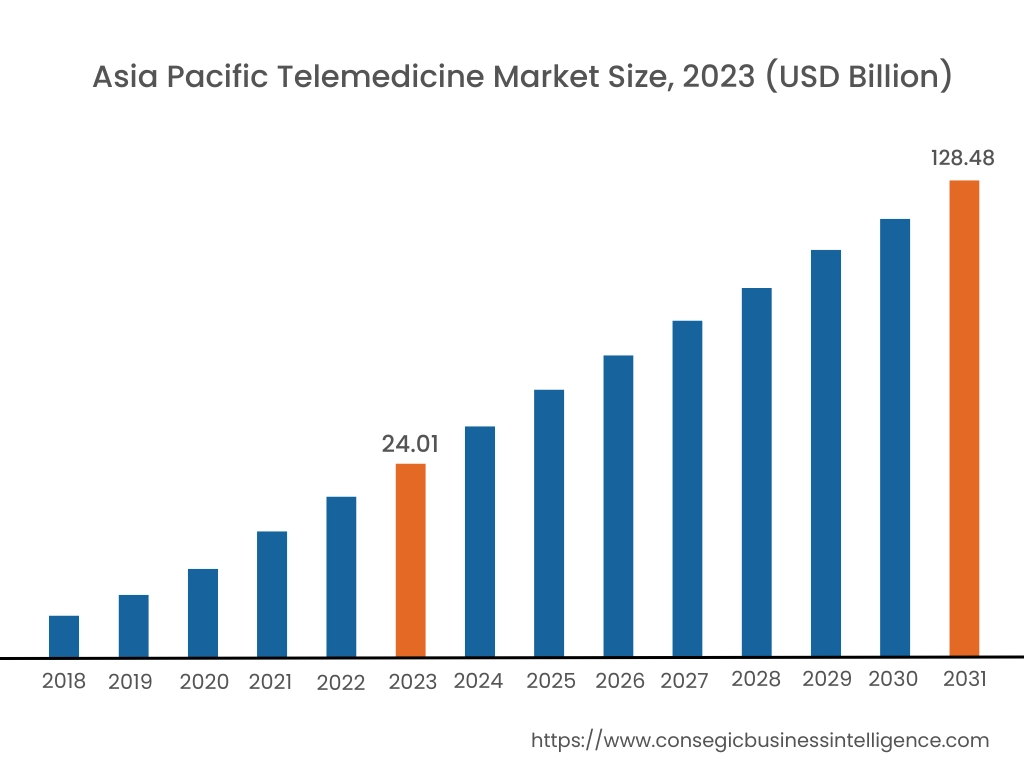
North America is estimated to reach over USD 173.53 Billion by 2031 from a value of USD 50.53 Billion in 2023.
The main factors propelling telemedicine's adoption in North America include technology developments, its integration with insurance models, and its broad use in healthcare facilities. Increased patient demand for remote care, favorable regulatory developments, and large expenditures in telehealth infrastructure are driving this development. The adoption of cutting-edge systems, increased coverage by health insurance companies, and high consumer acceptance of digital health solutions are the main forces behind this growth. The continuous initiatives to expand patient convenience and provide access to healthcare services also help to fuel the telemedicine market expansion in the area.
Asia Pacific region was valued at USD 24.01 Billion in 2023. Moreover, it is projected to grow by USD 28.91 Billion in 2024 and reach over USD 128.48 Billion by 2031. Out of this, China accounted for the maximum revenue share of 28.4%.
The market is anticipated to grow rapidly in the Asia Pacific area as a result of rising usage of digital health technology, growing healthcare requirements, and favorable government regulations. The region's growing middle class, increasing internet penetration, and big and diversified population make it a major growth engine. Key drivers of this rise include wearable technology, government measures to increase healthcare access, and advancements in mobile health applications. The focus on improving healthcare delivery and getting around conventional infrastructural constraints encourages growth in the area.
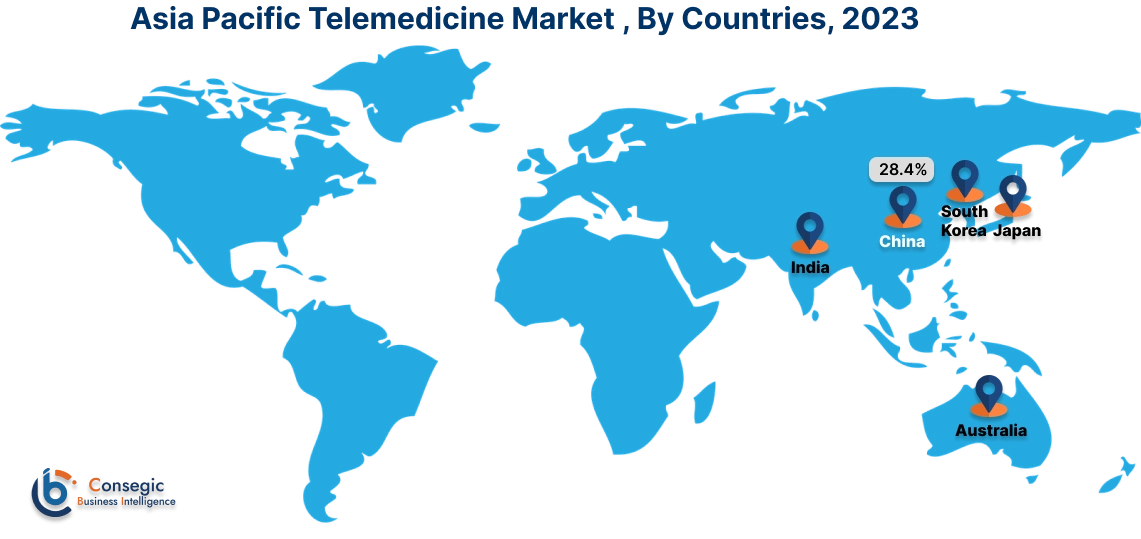
According to the telemedicine market analysis, Europe is expected to have substantial growth supported by a high degree of healthcare digitization, rising demand for distant consultations, and supportive regulatory frameworks. significant telehealth infrastructure investments, broad adoption of digital health technologies, and a significant emphasis on enhancing healthcare efficiency and accessibility are characteristics of the European market. The region's dynamic growth trajectory is attributed to its commitment to integrating telemedicine into mainstream healthcare practices and the continuous advancements in technology.
Due to rising healthcare needs, developments in digital health technology, and encouraging government initiatives, the sector in the Middle East, Africa, and Latin America is predicted to rise at a significant rate. With notable advancements being made in nations like Brazil and the United Arab Emirates, the area is witnessing a change towards more affordable and effective healthcare options. The use of telemedicine services is being fuelled by increases in internet connectivity, growing healthcare expenditures, and initiatives to increase access to healthcare in underprivileged areas. The emphasis on enhancing healthcare delivery and utilizing technology to address local healthcare issues is what defines this rise.
Top Key Players & Market Share Insights:
The Telemedicine market is highly competitive with major players providing products to the national and international markets. Key players are adopting several strategies in research and development (R&D), product innovation, and end-user launches to hold a strong position in the market. Key players in the telemedicine industry include-
- Teladoc Health, Inc.(US)
- American Well (US)
- Practo (India)
- TeleClinic (Germany)
- Ada Health(Germany)
- MDLive (USA)
- Doxy.me (USA)
- Doctor on Demand (USA)
- Babylon Health (UK)
Recent Industry Developments :
Product launches
- In May 2024, Teladoc Health launched a new mental health platform aimed at providing comprehensive mental health care through virtual visits, enhanced by AI-driven insights.
- In June 2024, Amwell introduced an upgraded version of its telehealth platform featuring improved integration with electronic health records (EHRs) and new patient engagement tools.
- In June 2024, Televero Health introduced a comprehensive platform that combines primary care, specialty consultations, mental health services, and chronic disease management into a single digital ecosystem. This approach aims to enhance care coordination, improve patient outcomes, and provide a more cohesive experience for users by consolidating multiple healthcare services into one accessible platform.
- In May 2024, SkinVision launched a new suite of mobile apps featuring advanced imaging capabilities specifically designed for diagnosing and monitoring skin conditions. These apps utilize high-resolution imaging and AI-powered analysis to assist users in detecting potential skin issues such as melanoma and other dermatological conditions early.
- In April 2024, AliveCor released several new wearable devices designed for continuous cardiac monitoring. These devices, including the KardiaMobile 6L and KardiaMobile 1L, offer advanced features for real-time heart rhythm tracking and remote patient management. The new wearables enhance remote care by providing detailed ECG readings and integrating with telehealth platforms, allowing healthcare providers to monitor patients' cardiac health more effectively and respond promptly to any irregularities.
Mergers & Acquisitions
- In July 2024, Australian telehealth provider HealthEngine acquired Practice Ignition to enhance its telehealth offering and integrate more robust appointment scheduling and management features.
Telemedicine Market Report Insights :
| Report Attributes | Report Details |
| Study Timeline | 2018-2031 |
| Market Size in 2031 | USD 449.56 Billion |
| CAGR (2024-2031) | 18.6% |
| By Component |
|
| By Application |
|
| By Installation |
|
| By Modality |
|
| By End-User |
|
| By Region |
|
| Key Players |
|
| North America | U.S. Canada Mexico |
| Europe | U.K. Germany France Spain Italy Russia Benelux Rest of Europe |
| APAC | China South Korea Japan India Australia ASEAN Rest of Asia-Pacific |
| Middle East and Africa | GCC Turkey South Africa Rest of MEA |
| LATAM | Brazil Argentina Chile Rest of LATAM |
| Report Coverage |
|
Key Questions Answered in the Report
How big is the telemedicine Market? +
Telemedicine Market size is estimated to reach over USD 449.56 Billion by 2031 from a value of USD 114.86 Billion in 2023 and is projected to grow by USD 134.17 Billion in 2024, growing at a CAGR of 18.6% from 2024 to 2031.
Which is the fastest-growing region in the telemedicine Market? +
Asia-Pacific is the region experiencing the most rapid growth in the telemedicine Market.
What specific segmentation details are covered in the telemedicine report? +
The telemedicine report includes specific segmentation details for components, mode of delivery, application, modality, end-user, and region
Who are the major players in the telemedicine market? +
The key players in the telemedicine market are Teladoc Health, Inc. (US), American Well (US), MDLive (USA), Practo (India), TeleClinic (Germany), Ada Health (Germany), Doxy. me (USA), Doctor on Demand (USA), and Babylon Health (UK).
